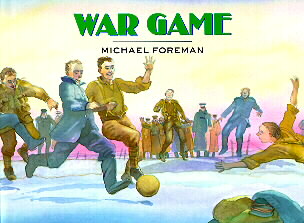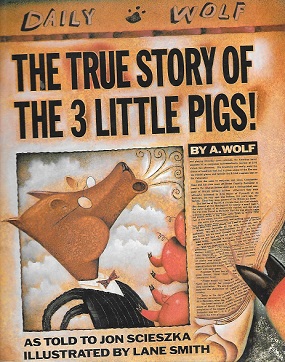
"The Three Little Pigs" is a fable about three pigs who build their houses of different materials. A Big Bad Wolf blows down the first two pigs' houses which are made of straw and sticks respectively, but is unable to destroy the third pig's house that is made of bricks. The printed versions of this fable date back to the 1840s, but the story is thought to be much older. The earliest version takes place in Dartmoor with three pixies and a fox before its best known version appears in English Fairy Tales by Joseph Jacobs in 1890, with Jacobs crediting James Halliwell-Phillipps as the source.

The Big Bad Wolf is a fictional wolf appearing in several cautionary tales, including some of Grimms' Fairy Tales. Versions of this character have appeared in numerous works, and it has become a generic archetype of a menacing predatory antagonist.
The Carnegie Medal for Illustration is a British award that annually recognises "distinguished illustration in a book for children". It is conferred upon the illustrator by the Chartered Institute of Library and Information Professionals (CILIP) which inherited it from the Library Association. CILIP is currently partnered with the audio technology company Yoto in connection with the award, though their sponsorship and the removal of Greenaway’s name from the medal proved controversial.

War Game is a children's novel about World War I written and illustrated by Michael Foreman and published by Pavilion in 1993. It features four young English soldiers and includes football with German soldiers during the Christmas truce, "temporary relief from the brutal and seemingly endless struggle in the trenches".

Lane Smith is an American illustrator and writer of children's books. He is the Kate Greenaway medalist (2017) known for his eclectic visuals and subject matter, both humorous and earnest, such as the contemplative Grandpa Green, which received a Caldecott Honor in 2012, and the outlandish Stinky Cheese Man, which received a Caldecott Honor in 1992.

The True Story of the 3 Little Pigs! is a children's book by Jon Scieszka and Lane Smith. Released in a number of editions since its first release by Viking Kestrel, an imprint of Viking Penguin in 1989, it is a parody of The Three Little Pigs as told by the Big Bad Wolf, known in the book as "A. Wolf", short for "Alexander T. Wolf". The book was honored by the American Library Association as an ALA Notable Book.

Three Little Pigs is an animated short film released on May 25, 1933, by United Artists, produced by Walt Disney and directed by Burt Gillett. Based on the fable of the same name, the Silly Symphony won the 1934 Academy Award for Best Animated Short Film of 1933. The short cost $22,000 and grossed $250,000.
Michael Foreman is a British author and illustrator, one of the best-known and most prolific creators of children's books. He won the 1982 and 1989 Kate Greenaway Medals for British children's book illustration and he was a commended runner-up five times.
Colin McNaughton is a British writer and illustrator of over seventy children's books. He is also a poet, focusing mainly on humorous children's poetry. He trained in graphic design at the Central School of Art and Design in London followed by an MA in illustration at the Royal College of Art. He lives in London.

Lauren Margot Peachy Child is an English children's author and illustrator. She is best known for the Charlie and Lola picture book series and other book series. Her influences include E. H. Shepard, Quentin Blake, Carl Larsson, and Ludwig Bemelmans.
Janet Ahlberg and Allan Ahlberg were a British married couple who created many children's books, including picture books that regularly appear at the top of "most popular" lists for public libraries. They worked together for 20 years until Janet's death from cancer in 1994. He wrote the books and she illustrated them. Allan Ahlberg has also written dozens of books with other illustrators.
Mitsumasa Anno was a Japanese illustrator and writer of children's books, known best for picture books with few or no words. He received the international Hans Christian Andersen Medal in 1984 for his "lasting contribution to children's literature."

Eugene Trivizas is a Greek sociologist and writer of children's books. For his lasting contribution as a children's writer, Trivizas was a finalist for the biennial, international Hans Christian Andersen Award in 2006.

Patricia Evelyn Hutchins was an English illustrator, writer of children's books, and broadcaster. She won the 1974 Kate Greenaway Medal from the Library Association for her book The Wind Blew. On screen, she was best known as 'Loopy-Lobes' the second owner of the "Ragdoll boat" in the long-running children's series Rosie and Jim.

Anthony Edward Tudor Browne is a British writer and illustrator of children's books, primarily picture books. Browne has written or illustrated over fifty books, and received the Hans Christian Andersen Award in 2000. From 2009 to 2011 he was Children's Laureate.
The Kurt Maschler Award was a British literary award that annually recognised one "work of imagination for children, in which text and illustration are integrated so that each enhances and balances the other." Winning authors and illustrators received £1000 and a bronze figurine called the "Emil".
John Burningham was an English author and illustrator of children's books, especially picture books for young children. He lived in north London with his wife Helen Oxenbury, another illustrator. His last published work was a husband-and-wife collaboration, There's Going to Be a New Baby, written by John and illustrated by Helen for "ages 2+".
Helen Gillian Oxenbury is an English illustrator and writer of children's picture books. She lives in North London. She has twice won the annual Kate Greenaway Medal, the British librarians' award for illustration and been runner-up four times. For the 50th anniversary of that Medal (1955–2005) her 1999 illustrated edition of Alice's Adventures in Wonderland was named one of the top ten winning works.
Emily Gravett is an English author and illustrator of children's picture books. For her debut book Wolves published in 2005 and Little Mouse's Big Book of Fears published three years later, she won the annual Kate Greenaway Medal recognising the year's best-illustrated British children's book.

The Jolly Postman or Other People's Letters is an interactive children's picture book by Janet and Allan Ahlberg. The innovative project required five years to complete, and much discussion with both the publisher Heinemann and the printer before it was issued in 1986. The first subject heading assigned by WorldCat is "Toy and movable books". Little, Brown published a U.S. edition in the same year.











